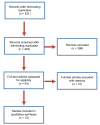Adolescent pre-exposure prophylaxis for HIV prevention: current perspectives
- PMID: 29238237
- PMCID: PMC5716324
- DOI: 10.2147/AHMT.S112757
Adolescent pre-exposure prophylaxis for HIV prevention: current perspectives
Abstract
Adolescents are a critical population that is disproportionately impacted by the HIV epidemic. More than 2 million adolescents between the age group of 10 and 19 years are living with HIV, and millions are at risk of infection. HIV risks are considerably higher among girls, especially in high-prevalence settings such as eastern and southern Africa. In addition to girls, there are other vulnerable adolescent subgroups, such as teenagers, who use intravenous (IV) drugs, gay and bisexual boys, transgender youth, male sex workers, and people who fall into more than one of these categories. Pre-exposure prophylaxis (PrEP) is a new intervention for people at high risk for acquiring HIV, with an estimated HIV incidence of >3%. Recent data from trials show evidence of the efficacy of PrEP as a powerful HIV prevention tool in high-risk populations, including men who have sex with men, HIV-1-serodiscordant heterosexual couples, and IV drug users. The reported efficacy in those trials of the daily use of oral tenofovir, alone or in combination with emtricitabine, to prevent HIV infection ranged from 44% to 75% and was heavily dependent on adherence. Despite the proven efficacy of PrEP in adult trials, concerns remain about its feasibility in real-life scenarios due to stigma, cost, and limited clinician experience with PrEP delivery. Recent studies are attempting to expand the inquiry into the efficacy of such HIV prophylaxis approaches in adolescent populations, but there are still many gaps in knowledge, and no country has yet approved it for use with adolescents. The aim of this review was to identify and summarize the evidence from studies on PrEP for adolescents. We have compiled and reviewed published studies focusing on safety, feasibility, adherence to therapeutics, self-perception, and legal issues related to PrEP in people aged between 10 and 24 years.
Keywords: HIV prevention; adolescents; pre-exposure prophylaxis (PrEP); youth.
Conflict of interest statement
Disclosure The authors report no conflicts of interest in this work.
Figures
Similar articles
-
Retention, engagement, and adherence to pre-exposure prophylaxis for men who have sex with men and transgender women in PrEP Brasil: 48 week results of a demonstration study.Lancet HIV. 2018 Mar;5(3):e136-e145. doi: 10.1016/S2352-3018(18)30008-0. Epub 2018 Feb 18. Lancet HIV. 2018. PMID: 29467098 Clinical Trial.
-
Anti-retroviral Therapy Based HIV Prevention Among a Sample of Men Who Have Sex with Men in Cape Town, South Africa: Use of Post-exposure Prophylaxis and Knowledge on Pre-exposure Prophylaxis.AIDS Behav. 2016 Dec;20(Suppl 3):357-364. doi: 10.1007/s10461-016-1536-1. AIDS Behav. 2016. PMID: 27631366
-
Protocol for an open-label, single-arm trial of HIV pre-exposure prophylaxis (PrEP) among people at high risk of HIV infection: the NSW Demonstration Project PRELUDE.BMJ Open. 2016 Jun 20;6(6):e012179. doi: 10.1136/bmjopen-2016-012179. BMJ Open. 2016. PMID: 27324719 Free PMC article. Clinical Trial.
-
Pre-Exposure Prophylaxis for HIV Prevention: Safety Concerns.Drug Saf. 2017 Apr;40(4):273-283. doi: 10.1007/s40264-017-0505-6. Drug Saf. 2017. PMID: 28130774 Free PMC article. Review.
-
Systemic preexposure prophylaxis for HIV: translating clinical data to clinical practice.Ann Pharmacother. 2014 Apr;48(4):507-18. doi: 10.1177/1060028014520880. Epub 2014 Jan 28. Ann Pharmacother. 2014. PMID: 24473492 Review.
Cited by
-
Adolescent and young adult Hodgkin lymphoma: Raising the bar through collaborative science and multidisciplinary care.Pediatr Blood Cancer. 2018 Jul;65(7):e27033. doi: 10.1002/pbc.27033. Epub 2018 Mar 30. Pediatr Blood Cancer. 2018. PMID: 29603618 Free PMC article. Review.
-
Awareness of Heightened Sexual and Behavioral Vulnerability as a Trigger for PrEP Resumption Among Adolescent Girls and Young Women in East and Southern Africa.Curr HIV/AIDS Rep. 2023 Dec;20(6):333-344. doi: 10.1007/s11904-023-00680-y. Epub 2023 Dec 5. Curr HIV/AIDS Rep. 2023. PMID: 38051383 Free PMC article. Review.
-
Knowledgeable, aware / interested: Young black women's perceptions of pre-exposure prophylaxis.Front Reprod Health. 2022 Sep 30;4:671009. doi: 10.3389/frph.2022.671009. eCollection 2022. Front Reprod Health. 2022. PMID: 36303637 Free PMC article.
-
Perspectives of Young Men Who Have Sex with Men on PrEP Adherence and Peer Navigation: A Qualitative Study.Arch Sex Behav. 2023 Jul;52(5):2037-2049. doi: 10.1007/s10508-023-02579-6. Epub 2023 Mar 20. Arch Sex Behav. 2023. PMID: 36940046 Free PMC article.
-
Learning to endure: A qualitative examination of the protective factors of homeless transgender and gender expansive youth engaged in survival sex.Int J Transgend Health. 2020 Nov 8;22(3):316-329. doi: 10.1080/26895269.2020.1838387. eCollection 2021. Int J Transgend Health. 2020. PMID: 34240074 Free PMC article.
References
-
- WHO . Health for the World’s Adolescents: A Second Chance in the Second Decade. Geneva: World Health Organization; 2014.
-
- WHO [webpage on the Internet] Adolescents Falling through Gaps in HIV Services. Available from: http://www.who.int/mediacentre/news/releases/2013/hiv-adolescents-201311... Accessed August 28, 2017
-
- Galvan A, Hare T, Voss H, Glover G, Casey BJ. Risk-taking and the adolescent brain: who is at risk? Dev Sci. 2007;10(2):F8–F14. - PubMed
Publication types
LinkOut - more resources
Full Text Sources
Other Literature Sources
Miscellaneous



